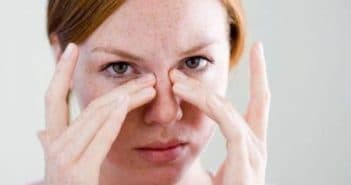
Maxillary sinusitis( code for μb 10 - j32) - an acute inflammatory process, localized in the maxillary sinuses. In these sinuses, mucus is formed, which quickly becomes purulent. Infection affects the inner epithelium of the sinuses themselves, which quickly leads to sinusitis. Very rarely the disease appears immediately. Therefore, most often sinusitis - the result of carelessness rights.
The first phases of the disease are diagnosed as rhinitis or common sinusitis. These are not such complex processes, often do not require cardinal treatment. If the runny nose in the initial stage or there is a risk of its appearance, then the sinusitis can be stopped even by folk remedies.
Usually the patient has about 5-7 days to localize the process and prevent the transition to sinusitis. The exception is only those people who have a history of chronic disease. In this case, it proceeds differently.
Content
- 1 Forms and types
- 2 causes and predisposing factors
- 2.1 first signs
- 2.2 Diagnostics
- 3 Treating sinusitis
- 3.1 Medicines
- 3.2 Home Treatment
- 4 Consequences
- 5 Video
Forms and types
 Sinusitis is classified by the shape of the percolation, the groundsand pathogens. There are two forms: chronic and acute. In acute sinusitis, the causative agent is a sudden viral infection, which became a complication after such diseases:
Sinusitis is classified by the shape of the percolation, the groundsand pathogens. There are two forms: chronic and acute. In acute sinusitis, the causative agent is a sudden viral infection, which became a complication after such diseases:
- measles;Scarlet fever
- ;
- rhinitis;
- ARVI;
- ARI;from this article you can find out what to do when there is no cough after ARI.
- cold( flu).
The acute form passes aggressively, almost unambiguously involving the ears of the patient. In general, sinusitis is dangerous precisely by a close ligament with the ear. Such a chain is dangerous for those who have the predis
laid down for otitis.
Chronic form is not so active even at the time of exacerbations. Here the character is more often sluggish, in which exacerbations are replaced by temporary remissions. Inflammation is almost constant, the symptoms are more even with the preservation of the main signs.
Infection often affects both sides, but its type may be different: infectious or bacterial. Viral sinusitis, in which a malignant agent is "implanted" with a primary disease. The cause of the bacterial type is the ingress of  bacteria from the cocci class.
bacteria from the cocci class.
Sinusitis is also divided by the severity of the flow and manifestation:
- is a catarrhal form. Sudden and acute form caused by the virus, but without complications;
- purulent form. To the attack of the virus joined the bacterium, eventually mucous was swollen;
- is traumatic. After the injury, blood remained in the sinuses, which caused infection.
Two additional forms appear as chronic: fungal type and polyposis. Develop slowly, without bursts. Rarely identified immediately, usually it is a random finding during routine inspections.
Causes and predisposing factors
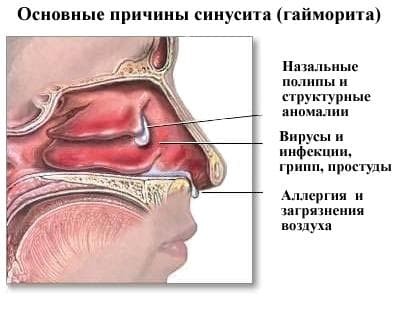
Three main causes of sinusitis
Sinusitis is a moody disease, its nature depends on the timeliness of treatment. It is important to pay attention to its provocateurs, especially if the anamnesis is predisposition to ENT diseases. To cause infection and create an ideal soil for the disease can:
- ARVI and ARD;
- rotten teeth;
- bacteria of cocci class;
- allergy;
- cold;
- influenza;
- anomalies in the structure.
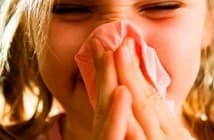 What is the treatment of thick nozzles in a child, is indicated in this article.
What is the treatment of thick nozzles in a child, is indicated in this article.
The adult snot has a brown color, what to do with this you can understand from this article.
The child has snot like water, which is indicated here: http: //prolor.ru/n/ lechenie-n / sopli-kak-voda-u-rebenka-chem-lechit.html
In these cases, the sinusitis is secondary and takes the form of a complication. But he is dangerous because he always starts a fatal bundle: sinusitis - otitis. It is extremely important to protect yourself from any hypothermia, especially the feet. The first reaction of the body to cold is a runny nose. And then the infection went "walk" through the body. If there is such a threat, you should immediately stop the probability of consequences. This is especially critical in the off-season, when the immune system weakens and diseases cease to obey protective barriers.
First signs of
The first sign of maxillary sinusitis  is the duration of the common cold. If the body is able to cope with the virus or a bacterium, the cure will take place within a week with the minimum of your participation. But if the runny nose lasts two weeks or more, this is already an excuse to talk about sinusitis. Yes, often by this time the patient is changing the color of mucus. It becomes thick, viscous, changes color to yellow or green.
is the duration of the common cold. If the body is able to cope with the virus or a bacterium, the cure will take place within a week with the minimum of your participation. But if the runny nose lasts two weeks or more, this is already an excuse to talk about sinusitis. Yes, often by this time the patient is changing the color of mucus. It becomes thick, viscous, changes color to yellow or green.
However, there is also a catarrhal form of the disease, in which mucus can remain transparent. Sinusitis is accompanied by several permanent symptoms:
- headache;
- hum in the head;
- tenderness in the region of the frontal lobes;
- permanent stiffness;
- is a bad condition.
If the process is purulent, it can cause a different temperature, worsening the condition. The hearing can decrease, the sense of smell disappears, the taste sensations change.
Diagnosis
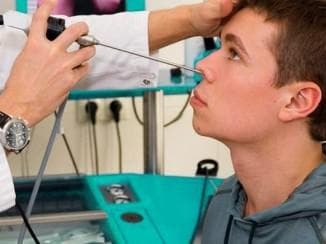 In general, the diagnosis of sinusitis includes three components:
In general, the diagnosis of sinusitis includes three components:
- a swab of the sinuses;
- Rhinoscopy;
- X-ray.
But experts rarely observe this order. Only x-rays of the sinuses are necessarily prescribed. This is a necessary step to determine the state of neglect. Then the sinus is inspected, and the complaints are the addition to the general picture.
Treatment of sinusitis
Medications
Almost 95% of the treatment of sinusitis starts with a procedure like sinus puncture. Extremely unpleasant procedure, but almost painless. The patient is given a local anesthetic and then the surgeon starts the puncture. During the operation, a person will feel a strong pressure on the head and inside the nose. This is because the doctor presses one hand on his head, and the second hand makes efforts to break through the septum. The whole process takes about 10 minutes.
The danger of sinusitis is so great and fraught with complications that even with complaints about otitis, the patient first check the condition of the sinuses.
At the slightest suspicion of maxillary sinusitis, a puncture is prescribed. This method allows you to completely remove the mucus. If necessary, put a catheter for further washing. Usually, the catheter is placed for 5 days, but puncture can be performed repeatedly. While the doctor does not see the dynamics of improvement, the patient lies in the clinic.
 At the same time, powerful modern antibiotics are prescribed for sinusitis, usually Cefotaxime. The drug group of third-generation antibiotics, well tolerated and has a huge spectrum of action. It is possible that an antibiotic will not be absorbed by the body and there will be no improvement. Normally, this doctor and he can see by the growing indicators of leukocytes. But there are predisposing forms of sinusitis and otitis, which are extremely difficult to treat.
At the same time, powerful modern antibiotics are prescribed for sinusitis, usually Cefotaxime. The drug group of third-generation antibiotics, well tolerated and has a huge spectrum of action. It is possible that an antibiotic will not be absorbed by the body and there will be no improvement. Normally, this doctor and he can see by the growing indicators of leukocytes. But there are predisposing forms of sinusitis and otitis, which are extremely difficult to treat.
If you have had or have severe medical history problems, tell your doctor. Pay attention to poor absorption of antibiotics, if it already was. Then the drug will be administered intravenously, which will make the result extremely effective.
Antiviral drugs are also prescribed: Arbidol, Sinupret. More often it is Sinupret, since its direction is the relief of sinusitis and sinusitis. If we are talking about the treatment of the chronicle, Sinupret-Fort is appointed. It has a longer duration and does not require reception by the clock.
The composition of therapy must include antihistamines: Suprastin, Diazolin. They help to cope with swelling and prevent the allergic reaction of the body to other drugs.
Treatment at home
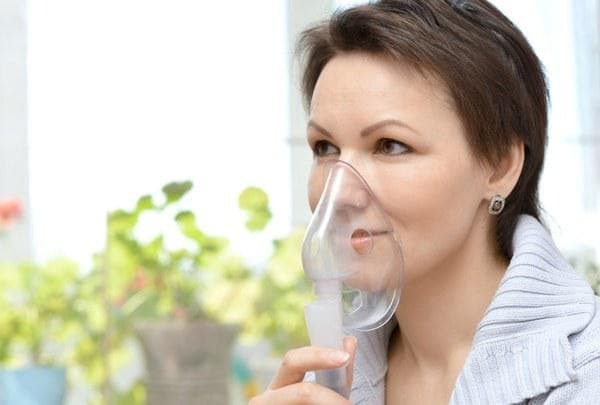
For the treatment of sinusitis, inhalation with nebulizer
Maxillary sinusitis is allowed to be treated at home only after a doctor's examination:
- with mild forms;
- when combined with a main therapy regimen;
- for rehabilitation after severe form.
To facilitate breathing and stopping the remnants of inflammation, inhalations for sinusitis on the basis of propolis are good. Add 3% to 30% of the tincture and actively breathe medical steam. What drops to treat sinusitis? You can prepare drops: in equal parts, take aloe, honey and celandine. Everything is mixed, diluted with water. Important: be careful with celandine! The herb is extremely poisonous and can lead to allergies and signs of intoxication when over-saturated. Drops are effective, but first make sure of the tolerance of the herb: take more portions of honey and aloe, and cleanse a pinch. So you will not suffer and maximum( with allergies) will be covered with urticaria.
Ideal sea-buckthorn in its pure form as a drop. She will remove swelling, protect against epithelium drying and stimulates immunity.
Consequences of
 Genyantritis is terrible "in anger", its minimal complication is otitis. But this is only one of the possible options. Complications of the whole spectrum:
Genyantritis is terrible "in anger", its minimal complication is otitis. But this is only one of the possible options. Complications of the whole spectrum:
- purulent, serous meningitis;
- brain abscess;
- casing damage and edema;
- reactive brain edema or retina.
After some sinusitis people go blind, go dead forever. Therefore, when treating a disease, it is better to raise an alarm in vain than to leave it on its own. And also do not forget about the prevention of sinusitis in the common cold.
Video
More information about sinusitis - in this video:
Sinusitis can leave a terrible imprint, especially neglected. Mortality increases by 3% every year. Only earlier treatment can save you from such an "acquaintance".
